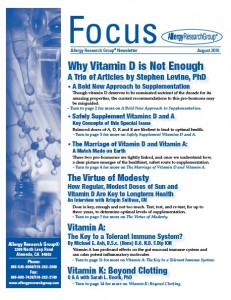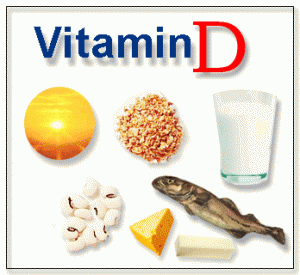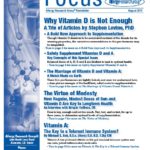 Krispin Sullivan is a licensed clinical nutritionist and educator, and author of Naked at Noon: Understanding the Importance of Sunlight and Vitamin D. She received her degree in dietetics at the University of Vermont in 1968, and her certification in nutrition from the National Institute of Nutrition Education in 1988. She is former director of the nutrition program for Northern California Recovery Systems in Mill Valley, California, and is licensed by the state of California to teach nutrition in post-secondary schools. She currently resides in Incline Village, Nevada, and is studying the microbiome in humans, and writing a book on microbial gut inhabitants as a protective shield.
Krispin Sullivan is a licensed clinical nutritionist and educator, and author of Naked at Noon: Understanding the Importance of Sunlight and Vitamin D. She received her degree in dietetics at the University of Vermont in 1968, and her certification in nutrition from the National Institute of Nutrition Education in 1988. She is former director of the nutrition program for Northern California Recovery Systems in Mill Valley, California, and is licensed by the state of California to teach nutrition in post-secondary schools. She currently resides in Incline Village, Nevada, and is studying the microbiome in humans, and writing a book on microbial gut inhabitants as a protective shield.
Her website is http://www.krispin.com
Focus: You’re a well-known advocate of safe, steady, modest doses of Vitamin D and sunlight. Before we look at the details of your clinical expertise, can you summarise your philosophy?
KS: Knowledge about safe use of sunlight and vitamin D should be an intrinsic part of our basic health education. As of today, many of us, of all ages and races, don’t have enough vitamin D. Vitamin D has a profound antioxidant and membrane stabilising potential—so much so that while vitamin A, beta-carotene, vitamin E, the B vitamins and vitamin C are destroyed by light, heat and oxygen, vitamin D alone remains stable.
While we are close to knowing what optimal levels of serum vitamin D are likely to be—we cannot easily assess what an individual person needs to maintain that optimal 25(OH)D, given variations in exposure to UV-B sunlight based on geography and time of day, skin colour, diet, lifestyle, and complicating factors such as liver disease or how many vitamin D receptors cells are actually expressing and active. America is a big melting pot with tropical, temperate, subtropical and arctic latitudes, with skins ranging from very pale to very dark, with different genetics, different diets, different lifestyles, and a widely varying ability to produce vitamin D.
Focus: What concerns you about the current recommendations for vitamin D supplementation?
KS: We can’t overlook the fact that when oral intake (with or without sunning) is excessive, vitamin D is shunted into our fat cells, and high storage levels in human fat cells may be dangerous. At no time in human history could humans or animals have gotten the excessive doses of vitamin D being used today in research, medicine, and animal husbandry. The ‘idea’ of high dose vitamin D, which then is stored in fat, is very “user friendly”, but it presents the possibility of chronic toxicity, and that potential increases further if the patient combines treatment with sun exposure or other supplements or foods containing vitamin D. High doses are now available without a prescription and are commonly advised by “experts” and considered safe. The markers being used to watch for vitamin D toxicity, elevated serum calcium and/or urinary calcium, are not the only effects of high dose D and may be late effects of moderate chronic excessive intake of vitamin D.
The human body is designed to adapt to conditions in the environment over time. We need to think about vitamin D supplementation in terms of years, not weeks. In the long term there is no evidence that high doses are more effective than regular, more physiologic intake of D. Modest, physiological doses of vitamin D and sunlight are both safe and effective. In an August 1997 editorial in the Annals of Internal Medicine, Bernadette M. Marriott, PhD, noted that researchers in the early 1990’s had expressed “concern about the potential for more widespread occult hypercalciuria and vitamin D toxicity given the high level of dietary supplement use in the United States today.” Certainly, increased incidence of soft tissue calcification (arteries) and/or bone loss in persons with 25(OH)D above 70 ng/ml has been reported.
Vitamin D as hormone/messenger has at least fifty known cellular targets, according to Walter Stumpf, Ph.D., with more being discovered every year. Most of these cellular targets are not related to bone. As research continues it will be confirmed: getting enough but not too much vitamin D is very important to human health and longevity.
Focus: What, then, is the answer? Too much, too little—how do we get the right amount?
 KS: Several sites on the internet provide the ability for persons to order their own D test, prices ranging from $60 (if you sign up for twice a year automatic testing) to about $80. Or, forward thinking physicians will typically order testing for patients who request it. To determine how much vitamin D one has, and monitor sun or supplement results, will take a minimum of 7 tests over a 3 year period. That’s a total cost of about $420 per person. After a three year period you will have a pretty good idea of your individual need, your personal response to sunlight and supplements. It is impossible to imagine the cost savings we’d have as a society by reducing vitamin D deficiency related ailments—from diabetes to heart disease, obesity, degenerative joint disease, osteoporosis, tooth loss, gum disease, and back pain.
KS: Several sites on the internet provide the ability for persons to order their own D test, prices ranging from $60 (if you sign up for twice a year automatic testing) to about $80. Or, forward thinking physicians will typically order testing for patients who request it. To determine how much vitamin D one has, and monitor sun or supplement results, will take a minimum of 7 tests over a 3 year period. That’s a total cost of about $420 per person. After a three year period you will have a pretty good idea of your individual need, your personal response to sunlight and supplements. It is impossible to imagine the cost savings we’d have as a society by reducing vitamin D deficiency related ailments—from diabetes to heart disease, obesity, degenerative joint disease, osteoporosis, tooth loss, gum disease, and back pain.
At the same time, we’d avoid both acute and chronic toxicity issues. There is no policy in the U.S. supporting regular testing of 25(OH)D levels. Why not? In the three years of writing Naked at Noon more than 300 of my clients were screened regularly. The results made it clear that we simply could not have estimated their blood levels accurately based on any known markers, whether sun exposure, intake of D supplements, food intake, skin colour, latitude, or any other known D marker. Serum testing for 25(OH)D is the only way we can know how much D we have.
Variables abound. For instance, Asian Indians (and perhaps others) have an excess of an enzyme that degrades vitamin D, so they may need higher amounts of supplementation or sun to maintain adequate serum D. While some of us may need more D or sunlight because of genetics or life style, combining supplements and sun may lead to excess serum vitamin D in others. The human body does not have a ‘feedback’ to turn off the conversion of oral or sun produced D into 25(OH)D.
Focus: Talk to us about excess vitamin D and toxicity.
KS: When I first began exploring vitamin D in 2000, I spoke with Barbara Boucher, M.D., of Royal London Hospital. She is one of the world’s top researchers on vitamin D and Syndrome X. I mentioned researcher Reinhold Vieth’s idea that higher doses of vitamin D were safe and perhaps necessary. She strongly disagreed with any suggestion that vitamin D in high doses for extended periods of time would be safe and her tone was so intense and serious that her caution stuck with me over the three year period of writing Naked at Noon.
Focus: Do you agree with her a decade later?
KS: Let me put it this way: there is no sufficient evidence that values of 25(OH)D over 70 ng/ml are natural, healthy, optimal, or safe. In many cases, elevated 25(OH)D levels don’t appear until the second or third year of continued moderately excessive supplementation.
Intoxication, hypervitaminosis D or vitamin D poisoning are terms reserved for very high levels of 25(OH)D accompanied by elevated serum and/or urinary calcium and potential or actual calcification of soft tissues. But accepting hypercalcemia as the main indicator of excessive vitamin D may be a mistake. Some research suggests excess (higher than normal but not ‘toxic) blood levels of sunlight-derived cholecalciferol, or oral ergo or cholecalciferol (vitamin D2 or D3), or excess 25(OH)D may actually interfere with the actions of the active hormone (messenger) vitamin D—1,25(OH)2D. Vitamin D as hormone/messenger has at least fifty known cellular targets, according to Walter Stumpf, Ph.D., with more being discovered every year. Most of these cellular targets are not related to bone. As research continues it will be confirmed: getting enough but not too much vitamin D is very important to human health and longevity.
I believe we need to re-evaluate the term ‘storage’ as used regarding vitamin D. Actual, usable storage D is 25(OH)D, the precursor to 1,25(OH)2D. That is why it is an important number, your ‘storage’ value for what can become the active hormone. Once D2 or D3 is shunted into fat cells, it is very difficult to get it back out unless starvation or fasting (destruction of the fat cell) occurs. This is supported by numerous studies showing serum 25(OH)D decline in winter even when summer sun has been abundant. There is no evidence to support any excess D coming back out of ones cells during winter months when it might be needed. Levels just continue to drop until the sun returns and sunning occurs.
When we produce vitamin D on our skin it’s rapidly bound to D-binding protein, carried to the liver and converted to 25(OH)D. When we take vitamin D orally, it is absorbed from the gut through the liver for conversion to 25(OH)D but as the amounts are much greater than that delivered by sunlight, excess D2 or D3 will be removed through the lymph system to be stored as D2 or D3 in fat cells. Some of the ergo or cholecalciferol will be bound to D-binding protein, and some will be carried off into fat cells. Animal and human cadaver research has shown that high doses of oral vitamin D (as D2 or D3) rapidly accumulate in fat cells as D2 or D3. Taking 5,000 or 10,000 IU daily may give you the test result you want but continued use of that same dose after fat cells are saturated may continue to raise your vitamin D beyond known safe limits. I’ve seen serious consequences result from taking 3000 IU of vitamin D daily over the course of a year—with bone pain, malaise, and bone loss at a blood level of 110 ng/ml.
In the three years of writing Naked at Noon more than 300 of my clients were screened regularly. The results made it clear that we simply could not have estimated their blood levels accurately based on any known markers.
Once fat cells are saturated it may take quite a while to lower serum levels of vitamin D and or 25(OH)D. In December of 2001 a patient being treated by his doctor for psoriasis with a special, narrowband UV-B light tested at 97 ng/ml. The light treatment was immediately stopped by the choice of the patient, who then left for his yearly trip to Hawaii, staying three months, from January to March of 2002. He ate local foods, including eggs and fish (relatively rich in vitamin D). On his return to northern California his 25(OH)D had risen to 127 ng/ml. He had used no supplements containing vitamin D. Over the next year his 25(OH)D dropped very slowly, just 6 ng/ml per month—and that was with complete avoidance of sunlight, D supplements and any vitamin D-rich foods. After 8 months of avoidance, his D dropped to a safer 78 ng/ml, and after 12 months of avoidance, his 25(OH)D fell to 57 ng/ml. This patient’s elevated 25(OH)D was initially caused by prescription UV-B light psoriasis treatment, and worsened by exposure to tropical sun. This demonstrates that when fat cells have absorbed as much D as they are able, with continued sun exposure or oral intake blood levels will continue to rise, and it may take rigorous avoidance of all sources of vitamin D over a long period of time to return serum 25(OH)D to generally agreed-on optimal levels.
 Excess vitamin D, whether as D2 or D3, will be drawn off into fat cells until these cells are saturated—and then vitamin D has nowhere to go and will remain in the serum. Unfortunately, neither in research nor in practice do we regularly test for levels of ergo or cholecalciferol nor consider the consequences of any excess unconverted levels of D. I believe this drawing off of excessive D is NOT storage but the body’s way of keeping us from the damage of excess serum D, exactly as the liver/lymph draws off fat soluble toxins, removing them from blood to keep us safe.
Excess vitamin D, whether as D2 or D3, will be drawn off into fat cells until these cells are saturated—and then vitamin D has nowhere to go and will remain in the serum. Unfortunately, neither in research nor in practice do we regularly test for levels of ergo or cholecalciferol nor consider the consequences of any excess unconverted levels of D. I believe this drawing off of excessive D is NOT storage but the body’s way of keeping us from the damage of excess serum D, exactly as the liver/lymph draws off fat soluble toxins, removing them from blood to keep us safe.
Focus: What do you consider a modest, physiological dose?
KS: The dose makes the medicine, doesn’t it? Dose is key, enough and not too much. In nature, there is always a measured optimum. The current AI (adequate intake) for vitamin D is 200 IU up to age 50, 400 IU from age 51-70, and 600 IU if you are over 70. The tolerable upper intake level (UL) is set at 2000 IU. These levels have been arrived at by the National Academy of Sciences Institute of Medicine. An individual’s actual need may vary remarkably, but I’d say for the majority of Americans between 800-2000 IU daily is a reasonable reference range. I believe that only rarely is more than 2000 IU daily needed once 25(OH)D reaches 40-60 ng/ml. In general, a dose of 1,000-2,000 IU may benefit most people without danger-but in some few it may be too much, and in others too little. Whether testing or maintaining, consistency is important. Regular daily use of 1,000-2,000 IU D over a year or longer will attain and maintain optimal 25(OH)D for many, but not all.
Focus: And what do you consider the optimal serum vitamin D level?
KS: A number of researchers have taken on this question. Research by Pierre Meunier from France found the optimal level of 25(OH)D to be not less than 30 ng/ml. With normal sun exposure, in areas where and when UV-B light is available, typical values of 25(OH)D appear to range from 40-65 ng/ml in the summer, dropping to the low 30’s during the winter. Interestingly, the vitamin D level of black rhinoceros living near the equator is about 55.7 ng/ml (not that higher promoted level of >70 ng/ml in the lifeguards located in tropical latitudes). Two women participating in vitamin D screenings for six years had levels between 55-60 ng/ml year round—both lucky enough to spend 3-4 months each winter in Hawaii or the Virgin Islands and with a diet high in eggs and fish, which have moderate levels of vitamin D. One symptom of suboptimal D may be elevated parathyroid hormone (PTH). A study in Europe found 25(OH)D levels greater than 31 ng/ml ensured most had normal PTH and greater than 40 ng/ml ensured none had elevated PTH. All this leads me to conclude that optimal levels are between 40-60 ng/ml, 40 ng/ml NOT being any better than 60 ng/ml. I expect persons to be closer to 40 ng/ml in the winter months and early spring and nearer 60 ng/ml in summer months.
Focus: In your book, you recommend vitamin D taken in concert with vitamin A in a fat soluble base. Will you talk about that?
KS: Vitamins A and D are partners in our cellular destinies. Vitamin A influences the production and balance of sex and adrenal hormones and supports the immune system. It is also necessary for vitamin D to work within our genes. Low vitamin A results in more infections and increased inflammation in epithelial cells as well as other immune problems. More recently vitamin A has been found to be a critical player in cellular energy production.
A relative excess of vitamin A or D appears to result in a relative, or functional, deficiency of the other vitamin. This is true even when blood levels of either one are within normal range, but the other excessive. This may be why in one early study by Mellanby, babies getting higher levels of vitamin A from milk and cream were more susceptible to rickets, the classic expression of vitamin D deficiency. When considering all the actions regulated by vitamins A and D, balance is everything. A number of professionals currently have suggested vitamin A prevents the benefits of vitamin D from manifesting, including the ‘anti-cancer’ benefit. What the studies do show is that when vitamin A is plentiful in the diet (because they are eating higher amounts beta-carotene containing foods and/or liver) and/or taking vitamin A supplements, higher amounts of D will be needed to ‘balance’ this equally important vitamin/hormone.
Because A and D (like E and K) are fat soluble nutrients, they must be taken with a meal containing significant fat. In addition, over the past 11 years I’ve seen better 25(OH)D response at lower doses using oil based A and D over dry capsules.
Focus: What are your recommendations for safe sunlight exposure?
KS: Basically, get ‘naked at noon’. If we try to get vitamin D when little UV-B light is present, we are likely to suffer skin damage before we make much vitamin D. On the other hand, if we sun when UV-B is most intensely present, many of us can get all the vitamin D we need before sun damage (erythema) occurs. Don’t let your skin “pinken”— ever. Erythema is not sunburn, it’s the slight redness or pinkening that occurs within 24 hours sun exposure. Knowing the point at which your skin will be damaged by UV-B light is important. Any pinkening or tenderness within 24 hours of sun exposure means you stayed too long. Even dark skins experience erythema though the ‘pinkening’ won’t be visible. It may be experienced as a slight tenderness of skin. This slight erythema is the cut off point I recommend for midday summer sun in most of America, and year round for southern America. I promote “naked at noon” literally, or when place inappropriate—long lunch hours in outdoor sidewalk cafes, wearing loose fitting clothing that easily arranged to allow skin exposure to sunlight as desired, or else act as a sun barrier. Research just published suggests having adequate, neither too little nor too much, UV-B exposure producing sufficient vitamin D3 may protect skin.
Unless you live in some of our most southern states or Hawaii or Puerto Rico, when you leave the house in the morning or go for a run after work, you are not likely to get much UV-B light. In much of America, so little UV-B is present in winter you’d need to spend most of the day outside, mostly naked, to get a tiny amount of vitamin D while exposing your skin to excessive UV-A, which is linked to melanoma and premature skin aging. UV-B is a very narrow band of light, whose intensity varies greatly from dawn to dusk, is strongest near noon and in the summer, at higher altitudes and nearer the equator.
Focus: What are some general guidelines you can give our readers about safely maximizing vitamin D through sun exposure?
With normal sun exposure, in areas where and when UV-B light is available, typical values of 25(OH)D appear to range from 40-65 ng/ml in the summer, dropping to the low 30’s during the winter.
KS: We have ‘D producing factories’ on our skin but only so much D is produced per ‘area’ of skin exposed, hence the ‘naked’. Just arms and legs aren’t likely to produce much D for many of us. We need backs and bellies to get sun too. In the US at latitudes above 30 degrees, sunning must occur between 11 am and 2 pm to get the UV-B needed for D production, hence the ‘noon’. Vitamin D production will be greatest and skin damage the least if your exposure is limited to the time just before any “pinkening”. At 35 to 40 degrees latitude, UV-B is sufficiently present midday from mid-April to mid-September. Above 40 degrees latitude, midday UV-B is sufficiently present from May through August. In the tropics and subtropics, UV-B is generally present most of the day all year long. Exposing our skins to sunlight when little UV-B is present will contribute to life-long UV-A over-exposure and skin aging/damage while producing little vitamin D. We need UV-B sunlight. When done correctly we can maximize vitamin D using supplements and sunlight without damaging our skin, unlike the tropical lifeguards with 25(OH)D at >70 ng/ml and assuredly aged and damaged skin.
Krispin Sullivan’s Recommendations
|
| Never expose your skin to sunlight for longer than needed to produce vitamin D. |
| Make sure UV-B is present at an intensity that allows rapid production of vitamin D before skin damage would occur when you sun. |
| Use clothing as sunblock when spending long periods of time in the sun. |
| Test your vitamin D, initially for a period of three years, to determine the optimal levels of sun and supplements needed to maintain your healthy levels. See what your 25(OH)D is at the end of summer, and test during mid-winter to be sure your levels have not dropped below 35 ng/ml. A test is available at http://www.grassrootshealth.net/. |
| Keep in mind that vegetarian, vegan and macrobiotic diets do not provide sufficient dietary vitamin D. Organ meats, eggs and fatty cold water fish do provide vitamin D. Cereals and grains increase the need for vitamin D. Oatmeal and other grains were found to increase incidence of rickets. |






1 Comment. Leave new
This review is amazing in its detail concerning storage of vitamin D and how slowly high levels revert to normal.